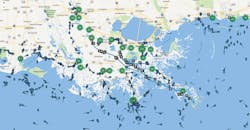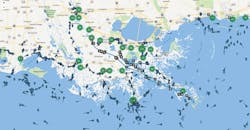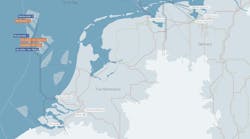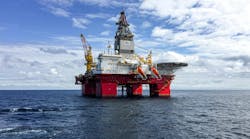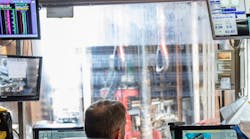Aaron Kline
Oceaneering
Offshore operators face growing pressure to reduce risk in the red zone and to make better use of manpower. One of the biggest risks to people and assets is from vessels – including those that are required for offshore drilling and production operations, as well as others that are simply passing over or near assets. Earlier methods of mitigating these risks – such as setting radar range limits and scheduling periodic overflights of critical assets – often diverted teams from other important activities and have generally been proven to be inadequate. The challenge is even more difficult for operators of multiple offshore assets, who must establish risk-management procedures across many geographically dispersed locations.
An increasingly popular alternative combines Automatic Identification System (AIS) data with radar and additional location-specific real-time input from multiple asset sites into a common operational view of all vessel activity. All live data feeds are monitored around the clock at a central shore-side location by teams that are specially trained to assess alerts, make initial risk assessments, and communicate only validated risks for immediate action. This approach enables operators to not only avert dangerous incidents, but also to deploy significantly more efficient risk-mitigation operations while freeing personnel to focus on other activities.
Early examples
Most major offshore operators have already employed AIS data for the past 10 years to monitor vessel activities for a variety of logistical and safety reasons. One of these operators began applying the technology to manage risk for remote assets located in the Gulf of Mexico and in the Caribbean. At an onshore location, the company consolidated all activities related to assessing the risk of collision by approaching vessels and alerting offshore crews no less than an hour before any vessel appeared to be passing dangerously close.
One of the operator’s objectives was to eliminate what previously had been a substantial variance in risk-management training, team size, and operational tempo across all of the organization’s platforms. It was impossible to apply risk-management policies and requirements consistently across all assets. The shore-side operation solved this problem while greatly improving the organization’s awareness of approaching vessel risks and consistently providing much earlier awareness about asset threats for speedier initiation of risk mitigation measures. In one case, the shore-side team identified an in-bound merchant shipping vessel more than three hours ahead of when it would otherwise have reached multiple high-value assets. Offshore crews were able to escalate mitigation activities and redirect the inbound vessel well before it became a more serious threat.
The Automatic Identification System, combined with radar, provides real-time input from multiple asset sites into a common operational view of all vessel activity. (Courtesy Oceaneering)
Another offshore operator had a slightly different challenge. The company had acquired a Gulf Coast pipeline that was in a high-risk environment for vessel impacts. The operator did not have a risk-mitigation process in place or experienced personnel to assist with both determining and initiating some kind of mitigating action. Like many organizations, it was operating with less staff than in the past, but now had to deal with significantly higher volumes of operational and risk-management data. The operator did not have the qualified team members or other dedicated resources to monitor a huge influx of information, validate triggered alerts, and respond to them. The company began outsourcing 24/7 AIS-based risk monitoring and evaluation to a professional third-party shore-side operation as a first line of defense to ensure that their attention was only on critical and actionable issues.
In these and other examples, a centralized shore-side risk-management operation overcomes the problems associated with earlier approaches and creates the opportunity for innovative new capabilities, such as establishing remote watch teams that have a consolidated view of all assets anywhere in the world. These teams enable organizations to allocate the proper attention to identified risks, while improving how information is managed. Highly experienced resources can be dedicated to some or all risk-management tasks, depending on requirements and resources. Plus, this approach can be used to uncover trends, along with vulnerability gaps, new risks, and better ways to mitigate them. Once best practices are established for one set of assets, organizations can use them with any type of critical infrastructure.
Getting started
Organizations will need four key elements to start a risk-mitigation program: 1) access to all necessary data for each defined risk; 2) a monitoring platform that can consolidate all data into a shared view and issue customized alerts; 3) clearly defined risk assessments and mitigation policies and procedures; and 4) a staff that has been trained to validate risks and initiate mitigation actions.
Every risk-management program should also deliver analytical reporting and easy access to historical vessel position data, along with triggered alerts, to optimize operational efficiency and emergency responses while facilitating the ongoing measurement of key performance indicators (KPIs). Regularly reporting on KPIs will help an operator measure program effectiveness, allow for continuous mitigation improvements, and enable operators to target these vessels for outreach and education as an additional preventive measure.
In addition to improving overall risk management, deploying a centralized monitoring platform also significantly increases the value of hardware deployed to the individual assets by providing overlapping regional coverage and helping to prevent blind spots or gaps in early assessments. Another hardware option is to deploy an AIS Aid to Navigation (ATON) and to program it to proactively send a safety message directly to the wheelhouse of an approaching vessel, warning its crew that it is approaching a fixed structure. •
